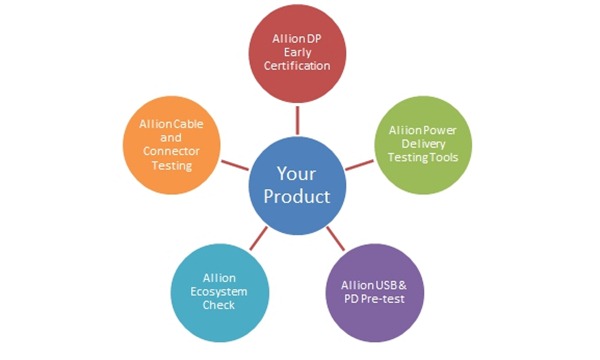
VESA has announced the up to date DisplayPort 1.4 standard, with promising support for 8K display and Alternate Mode on USB-C. In order to promote DisplayPort 1.4, VESA has hosted a series of workshops in Asia. Representatives from Allion attended the press conferences and workshops in Japan, Taiwan, and China. For this article, we share some important notes that are related to DisplayPort 1.4 standard and its certification.
USB-C has been gaining popularity recently; devices supporting DisplayPort Alt Mode on a USB-Type-C connector are able to connect to an existing DisplayPort device. Video source devices that support DisplayPort Alt Mode on a USB-C connector are able to utilize an appropriate adapter to drive HDMI, VGA, DVI display. Hence, smartphones, monitors, VR devices can provide excellent visual experience via DisplayPort and USB-C integration.
During the VESA press conference, Jim Choate, VESA compliance program manager, introduced the latest DisplayPort 1.4 standard. He mentioned that DisplayPort 1.4 had a 50-percent performance increase over the previous DP 1.3 standard and updated its new features, such as Display Stream Compression, Forward Error Correction, Multi-Stream Transport, etc.
Jim also stressed that DisplayPort 1.4 clearly stipulates the design specification for HBR3 (8.1Gbps) signals. In comparison, the previous DisplayPort 1.2 specification only supported transmission speeds up to 5.4 Gbps. Due to the increased bandwidth, DisplayPort 1.4 are able to support high-resolution 8K Videos.
Regarding to the power consumption issues, Jim said “care must be taken to make sure source and receiver both have antiquate capability to process 4K or 8K. ( Meaning source and receiver are able to support high resolution.) Take smartphones as an example, although HBR3 can support 8K but smartphone batteries or GPU may not fully support 8K performance. Therefore, we should take into consideration what kind of situation may require 8K and how to obtain 8K video source.” As a result, 8K or 4K is depends on practical applications.

Graphic 1. DP Link Rate Increase
Utilizing the DisplayPort Alt Mode standard, a USB-C connector and cable can deliver full DisplayPort audio/video performance. USB-C features including reversible USB interface, 10Gbit/s high speed transmission, power rate from 7.5 W (BC1.2 version) to 100W, etc. Those features provide developer opportunities to create differentiated products.
Jim also gave us some examples regarding USB-C and DisplayPort application (see Graphic 2). The first example is charging for the device. The second example depicts the dock’s ability to connect to different devices and transmit USB 2.0 or USB 3.1 data at the same time. The laptop signal can transmit to the monitor via dock, at the same time utilize an appropriate adapter to drive HDMI, VGA, DVI display. The third example is a USB-C to C cable can carry up to four DisplayPort channels. DP and USB 3.1 can be used in the same USB-C cable. Hence, there are two high speed channels for DP signals. For the USB power delivery, it can offer maximum 20V variable voltage and provide up to 100W power.

Graphic 2. Example USB Type-C Configurations
DP Alt Mode CTS will be available in early Q3 of 2016
USB-C certification is very complicated; hence, VESA provides DP Alt Mode early certification program. Currently, Allion Labs facilitates these test plans as part of the early certification program. Evelyn Chou, Allion Sales Manager, shared Allion’s test cases for early stage USB-C validation and mentioned how Allion assists customers to navigate problems. Ms. Chou said “According to our test experience, these new spec products are bound to have minor issues, and those problems would cause bad user experience and security issues. Therefore, DP Alt Mode certification program is very basic and important.” Third-party test labs such as Allion are able to assist vendors to achieve better quality control before launching their products to the market at the same time reduce the possibility of customer complaints.
Jim Choate said DP Alt Mode CTS has been made available in early Q3 of 2016. For DP Alt mode products, testing and certification is a significant procedure. Allion will continuously follow VESA and provide the latest information to our clients.
Currently, Allion can execute USB-C/DP Alt mode related tests include DP Alt Mode certification programs and USB-C pre-test (see graphic below). In addition, Allion provides Intel Thunderbolt testing.

Graphic 3
The new specifications will bring breakthrough in design and new challenges. Ms. Chou said “Our clients face a big challenge regarding USB-C / DP Alt mode has numerous design combinations. Therefore they lack the confidence to check all the details, plus, the peripheral products quality unstable, which is a pain in the backside for all developers.”
Allion utilizes our existing resources to develop Allion Total Solutions, which is able to assist USB-C / DP Alt mode product developers to negotiate these dilemmas. Our total solutions include 5 important items:
1. Elect the best materials for cable connectors in the early stage
2. Use Allion self-developed power delivery test tools to conduct product
certification
3. Use our abundant validation resources and product database to perform
interoperability testing
4. Conduct USB and Power Delivery Pretest
5. Indispensable Display Port Early Certification
If you have any questions related to DisplayPort certification, please contact us: service@allion.com







































